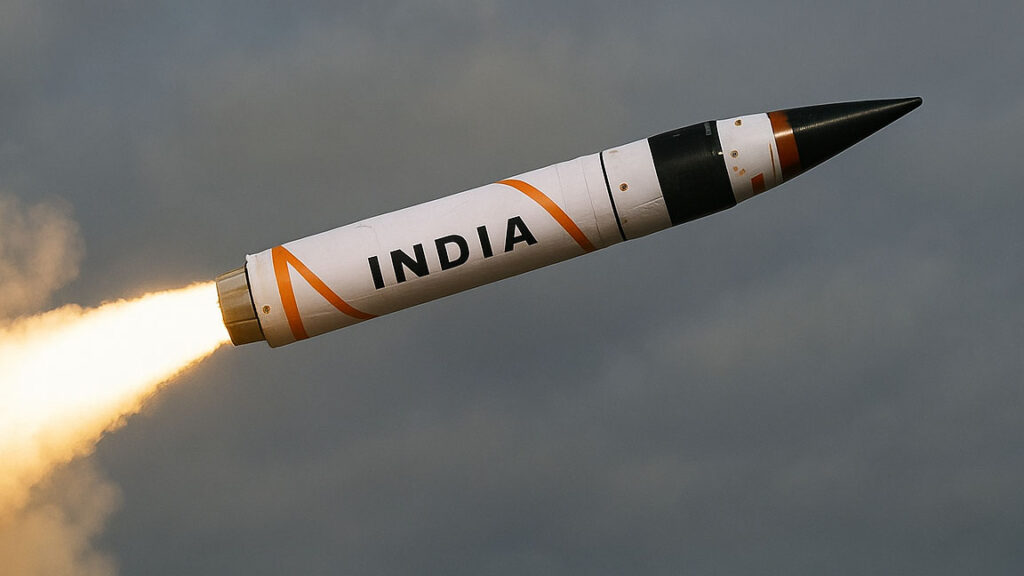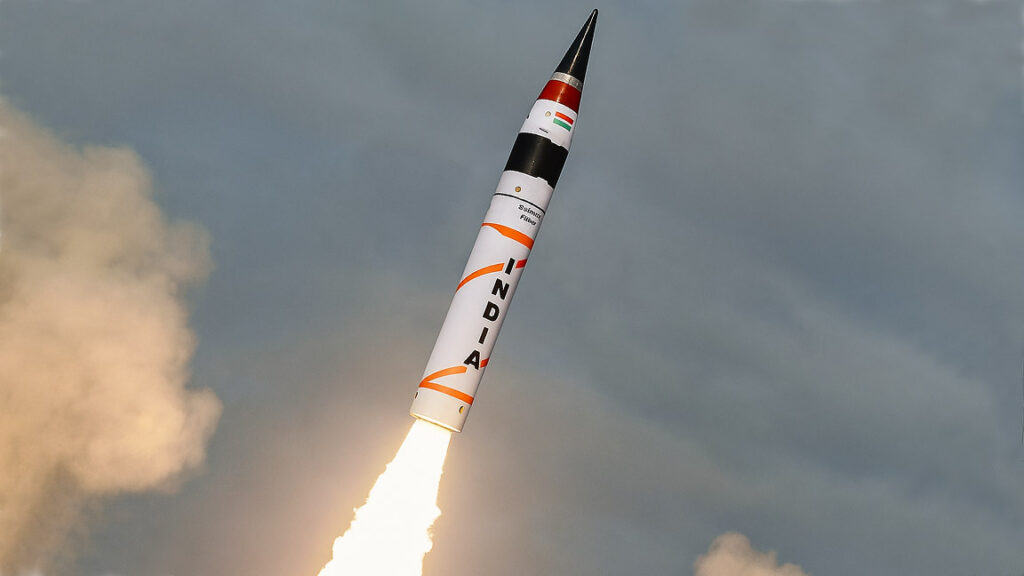Agni 5 test 2025 marked a defining moment for India’s strategic ascent, and it happened at Chandipur in Odisha between August 20–21, 2025. On these dates, the Advanced Test Range, Chandipur—officially called the Integrated Test Range (ITR)—witnessed a flawless launch that validated all technical and operational parameters. This event wasn’t just another missile trial; it firmly placed India among elite nations with credible long-range deterrence capabilities The Economic Times.
Let’s break that down simply: imagine firing a rocket that can travel up to 5,000 km—that’s enough to reach most of Asia and even parts of Europe. Now, add the fact that this is a nuclear-capable missile, and it becomes clear why this test felt like India announcing, “We’re ready, we’re capable, and we’re confident.” This wasn’t just engineering; it was strategy.
You might be wondering, “Why does all of that matter?” Well, in the coming sections, you’ll get to see exactly how this launch reshapes regional dynamics, what it means technically, and why it adds a new layer of credibility to India’s defense architecture. But for now, consider this your front-row seat to how Agni 5 test 2025 became a headline—and a historic one at that.
Details of the Agni 5 Test 2025 Launch 🚀
The Agni 5 test 2025 was successfully conducted on 20 August 2025 at the Integrated Test Range (ITR) in Chandipur, Odisha. Often called the Agni 5 Chandipur launch, this test was closely monitored by the Strategic Forces Command (SFC) along with the Defence Research and Development Organisation (DRDO).
Unlike earlier developmental trials, this launch was primarily meant to validate the operational readiness of the missile system. In simple words, India wasn’t just testing technology — it was demonstrating confidence that the missile can be deployed in real-world conditions.
One of the most striking aspects of the Agni 5 nuclear capable missile is its mobility and canister-based launch system. This allows the missile to be transported on road-mobile launchers, hidden from enemy surveillance, and launched at short notice. The test in August once again validated this mobility and precision factor, proving India’s ability to maintain a credible second-strike capability.
With a range of over 5,000 km, the Agni 5 missile range easily covers not just South Asia but also large parts of China and beyond. In fact, strategic analysts often point to the Agni 5 vs China range comparison, noting that major Chinese cities including Beijing and Shanghai fall well within its striking distance.
This successful trial makes headlines across defense circles as the Agni 5 missile news today, reinforcing India’s place among the few nations in the world capable of deploying long-range nuclear-capable systems. The August test was not just about one missile — it was about strengthening Agni 5 strategic deterrence, ensuring India’s security in an uncertain global environment.
Technical Features & Capabilities of Agni 5 test 2025🚀
When we talk about the Agni 5 test 2025, the biggest spotlight naturally falls on its unmatched technical features and futuristic capabilities. This missile is not just another step in India’s defense program — it’s a leap that positions the nation among the top global powers with long-range nuclear deterrence. Let’s break down its features in detail, in a way that’s easy to understand.
1. The Range Factor: Why 5,000 km Matters
The Agni 5 missile range is officially quoted as “over 5,000 km,” but experts believe it could go even further. This distance means India can reach almost the entire Asian continent, including critical regions in China, as well as parts of Europe and Africa. Compared to earlier Agni series missiles, which had shorter ranges (Agni-1 around 700 km, Agni-2 about 2,000 km, and Agni-4 up to 3,500 km), the Agni-5 is a strategic game-changer.
This is why many defense analysts often frame the debate around Agni 5 vs China range, because the missile is capable of covering major Chinese cities — a vital element in balancing regional power.
2. MIRV Capability: One Missile, Many Warheads
One of the most advanced features highlighted in the Agni 5 missile features is its MIRV (Multiple Independently targetable Re-entry Vehicle) technology. Simply put, this allows a single missile to carry multiple nuclear warheads, each targeting different locations.
- Initial tests validated 3–6 warheads,
- But operational deployment could potentially carry 10–12 warheads in the future.
This essentially means that if a crisis ever escalated, one launch could neutralize multiple high-value targets. That’s why the Agni 5 nuclear capable missile isn’t just about long distance — it’s about smart, efficient, and highly destructive deterrence.
3. Propulsion & Mobility
The missile uses a three-stage solid-fuel propulsion system, which ensures speed, reliability, and reduced launch preparation time. Earlier Agni missiles were larger and needed fixed launchpads, but the Agni 5 Chandipur launch demonstrated its road-mobile, canisterized system.
This mobility makes it much harder for enemies to track and pre-emptively strike, strengthening India’s second-strike capability under its No First Use nuclear doctrine.
4. Pinpoint Accuracy & Guidance
Another remarkable aspect of the Agni 5 test 2025 was its precision. The missile is equipped with advanced navigation and guidance systems, including a ring laser gyroscope and cutting-edge micro-navigation systems. Together, they give it a CEP (Circular Error Probability) of just a few dozen meters — which is extraordinary for a weapon of this scale.
5. Comparison With Earlier Variants
If we compare the Agni 5 missile features with earlier versions:
- Agni-1 & Agni-2 were short to medium range.
- Agni-3 & Agni-4 extended India’s reach but lacked MIRV and mobility.
- Agni-5, however, brings all these advancements together: range, mobility, nuclear payloads, and pinpoint accuracy.
This makes it not just a missile, but a pillar of India’s strategic deterrence in the 21st century.
Evolution of Agni-5 Program 🚀
The Beginning: Agni-1 to Agni-4
India’s Agni missile series didn’t start with Agni-5; it has been a long journey of learning, testing, and building credibility.
- Agni-1 (range ~700 km) was the first step, giving India short-to-medium range nuclear deterrence.
- Agni-2 (range ~2,000 km) expanded coverage, making sure India could respond beyond immediate borders.
- Agni-3 (range ~3,500 km) introduced heavier payload capacity and better accuracy.
- Agni-4 (range ~4,000 km) was a stepping stone toward true intercontinental reach, bringing advanced navigation and mobility.
Each step was not just about distance, but about refining precision, reliability, and survivability. All this gradually set the stage for Agni 5 test 2025, which represents India’s leap into long-range strategic deterrence.
The Making of Agni-5: DRDO’s Breakthroughs
The Agni-5 program began in the 2000s under the Defence Research and Development Organisation (DRDO). Its goal was clear — give India a credible, survivable deterrent that can reach far beyond South Asia.
Key milestones include:
- First major trials: Initial flight tests proved its three-stage solid-fuel propulsion.
- MIRV Integration: Over the years, India worked on Multiple Independently Targetable Re-entry Vehicles (MIRVs), allowing one missile to carry and deliver several nuclear warheads at once.
- Earlier tests: In March last year, India validated MIRV capability, showing that Agni-5 could strike multiple targets with precision.
The recent Agni 5 test 2025 at Chandipur ITR is seen as the culmination of years of refinement, confirming range, mobility, and strategic readiness.
Strategic Context: Why Agni-5 Matters
India’s nuclear posture is guided by its “No First Use” (NFU) policy, meaning it pledges not to launch nuclear weapons unless attacked first. In this framework, the role of Agni-5 becomes critical — it provides a second-strike capability that ensures no adversary can ever act without fear of assured retaliation.
With its range of up to 5,000 km, MIRV warheads, road-mobile launchers, and precision guidance, Agni-5 strengthens India’s hand against regional threats. This isn’t just about technology — it’s about ensuring credibility in deterrence.
The Agni 5 test 2025 proves that India’s missile arsenal is now at par with other global nuclear powers. It also signals a clear message: India’s defense is modern, mobile, and capable of responding decisively if required.
Evolution of the Agni-5 Program
1. Agni-1: India’s Bold First Step
- First launch: May 22, 1989, at Wheeler (now APJ Abdul Kalam) Island, Odisha, marking the debut of India’s solid-fuel missile era.
- Overview: Initially crafted from SLV-3 space booster components and Prithvi-I’s structure, Agni-1 demonstrated India’s capacity for reentry vehicle tech.
- Further tests: After a few recalibrations, it flew successfully in January 2002 and again on January 9, 2003. By 2007, it entered service with the Indian Army.
- Why it matters: Though its 700–1,200 km range was modest, Agni-1 laid the foundation for strategic deterrence—simple, road/rail mobile, and capable of carrying a nuclear payload.
2. Agni-2: Extending Influence
- Launch details: While a precise first date isn’t noted here, Agni-2 entered trials in the late 1990s, with launch exercises conducted from Wheeler Island and the Integrated Test Range in Odisha.
- Tech advance: It added a second solid-fuel stage, refining inertial guidance with multi-GNSS capabilities.
- Range and role: Achieved a leap to 2,000–3,500 km, a critical step in establishing credible regional deterrence.
3. Agni-3: Precision and Power
- First attempt: July 9, 2006, from Abdul Kalam Island—partially successful (airborne for 5 minutes).
- Successful launches: April 12, 2007, and multiple in 2008, 2010—each flight proving operational readiness and accuracy.
- Specs: Reached ~3,500 km with payloads up to 1.5 tonnes; boasted a circular error probability (CEP) under 40 m—a standout for strategic precision. Wikipedia
4. Agni-4: The Mobile Maverick
- Launch timeline:
- First test: November 15, 2011, from Wheeler Island.
- Full-range test: September 19, 2012—struck target ~4,000 km away.
- Later tests: January 20, 2014 (road-mobile user config), several through 2018, with one even in Chandipur (Sept 2024).
- Features: Two-stage solid-fuel technology, ring-laser gyro guidance (RINS), micro-navigation system (MINGS), launchable from road-mobile platforms. Payload capacity of ~1 tonne with very high accuracy.
5. Agni-5: The Breakthrough
- Initial flight: April 2012, from Wheeler Island—achieved over 5,000 km with near-perfect accuracy. [Test aimed at demonstrating ICBM-level reach.]
- Further launches:
- 2013: Successful full-range test.
- 2015–2018: Canister-launched from road-mobile platforms; multiple user trials and formal induction in 2019.
- MIRV milestone: March 11, 2024—India conducted its first flight test of Agni-5 with MIRV capabilities (Mission Divyastra), establishing independent targeting of multiple warheads.
- Why it’s game-changing: Agni-5 brought together intercontinental range (5,000+ km), road mobility, rapid deployment, and MIRV. With its advanced profile, it became central to India’s strategic deterrence.
The Making of Agni-5: DRDO’s Breakthroughs
The Agni-5 program began in the 2000s under the Defence Research and Development Organisation (DRDO). Its goal was clear — give India a credible, survivable deterrent that can reach far beyond South Asia.
Key milestones include:
- First major trials: Initial flight tests proved its three-stage solid-fuel propulsion.
- MIRV Integration: Over the years, India worked on Multiple Independently Targetable Re-entry Vehicles (MIRVs), allowing one missile to carry and deliver several nuclear warheads at once.
- Earlier tests: In March last year, India validated MIRV capability, showing that Agni-5 could strike multiple targets with precision.
The recent Agni 5 test 2025 at Chandipur ITR is seen as the culmination of years of refinement, confirming range, mobility, and strategic readiness.
Strategic Context: Why Agni-5 Matters
India’s nuclear posture is guided by its “No First Use” (NFU) policy, meaning it pledges not to launch nuclear weapons unless attacked first. In this framework, the role of Agni-5 becomes critical — it provides a second-strike capability that ensures no adversary can ever act without fear of assured retaliation.
With its range of up to 5,000 km, MIRV warheads, road-mobile launchers, and precision guidance, Agni-5 strengthens India’s hand against regional threats. This isn’t just about technology — it’s about ensuring credibility in deterrence.
The Agni 5 test 2025 proves that India’s missile arsenal is now at par with other global nuclear powers. It also signals a clear message: India’s defense is modern, mobile, and capable of responding decisively if required.

Strategic & Geopolitical Impact
Enhanced Deterrence Against China and Pakistan
With Agni 5 test 2025, India has significantly elevated its strategic posture. The missile’s ~5,000 km reach stretches into the heartlands of China and even parts of Europe, including Turkey. That’s not just a technical feat—it changes how India is viewed by its strategic competitors. For China, harboring long-standing border disputes and regional ambitions, Agni-5 is a credible counterweight. For Pakistan, even though it remains within shorter-range missile threat zones, Agni-5 introduces a deeper psychological shift: India is fast becoming a continental power, not just a regional one.
Regional Security Ripples
This launch quickly rippled across South Asia. While Islamabad’s official response remained cautious, analysts warned that Agni-5’s range could render Pakistan’s leadership bunkers and command centres vulnerable. In fact, a Pakistani strategic expert recently described India’s evolving missile capabilities as a game-changer that induces real anxiety over future vulnerabilities.
Beyond the Immediate Neighborhood
Agni-5’s strategic brilliance lies not just in geography but in symbolism—Turkey, much of Southeast Asia, and even parts of Europe now fall within India’s deterrence envelope. That signals India’s defense calculus is no longer South Asia-centric; it’s emerging in step with global powers that can project reach over continents.
Reinforced Through Multi-Tiered Readiness
Importantly, Agni-5 didn’t emerge alone. Earlier this year, India conducted operational tests of Prithvi-II and Agni-I, followed by the quasi-ballistic Pralay. Together, these short-, medium-, and long-range systems weave a layered, resilient defense fabric—not just one impressive missile, but an entire modernized arsenal primed for real-world scenarios.
Statements That Reflect the Tensions
- From Islamabad, public diplomatic wording remains polite, but security non-governmental experts have voiced stark concerns about India’s growing deterrence reach.
- In strategic circles in Delhi, Agni-5 is seen as a clarifying statement: India’s second-strike capability is now firmly operational—a cornerstone of its No First Use stance, made more credible through demonstrated technological strength.
Frequently Asked Questions (SEO-Ready)
1. What is Agni 5 test 2025?
The Agni 5 test 2025 refers to India’s successful validation of its long-range, nuclear-capable missile with a range of approximately 5,000 km. This test confirmed that all operational and technical parameters are ready for deployment and showcased India’s advanced deterrence capabilities.
2. How does this launch enhance India’s deterrence against China and Pakistan?
With a reach spanning deep into Chinese territory and even parts of Europe like Turkey, Agni 5 test 2025 raises the stakes in regional security. It assures India has a credible counterbalance to China’s expanding missile strength while subtly increasing Pakistan’s strategic anxiety—even though Pakistan itself falls within shorter-range threat zones.
3. How have recent missile tests like Prithvi-II, Agni-I, and Pralay strengthened India’s overall posture?
Together, these tests solidify a layered strategic shield:
- Prithvi-II (short-range, ~350 km) enhances tactical readiness.
- Agni-I (medium-range, ~700 km) reinforces battlefield deterrence.
- Pralay adds precision strike capability.
These, combined with Agni 5 test 2025, form a multi-tiered defense architecture—short, medium, and long-range coverage that’s operationally robust.
4. What did Pakistan say about India’s new missile capability?
Officially, Islamabad remains measured in response. Yet, strategic experts within Pakistan have admitted growing concerns—Agni-5’s multi-thousand-km reach into key urban and command zones increases anxiety about India’s second-strike ability and deep operational reach.
5. Does Agni 5 really make India a continental power?
While India has long been dominant in South Asia, the Agni 5 test 2025 pushes its strategic footprint across continents. Covering parts of Europe and all of China, this launch signals India’s transition from a regional actor to one with broader deterrent capability.
Final Thought ✍️
India’s Agni 5 test 2025 was not just another missile launch—it was a defining statement of intent. While China continues to modernize its arsenal and Pakistan responds with tactical rhetoric, India has chosen a calmer yet more powerful path: credible and layered deterrence.
The reach, accuracy, and reliability of Agni-5 prove that India’s security vision is not limited to its neighborhood but extends to a continental scale. Combined with the recent tests of Prithvi-II, Pralay, and Agni-I, the country has reinforced a full-spectrum deterrent—covering short, medium, and long ranges.
The message is clear: India seeks peace, but it is fully prepared to respond if challenged. This balance—strength backed by restraint—is what defines India’s defense doctrine today.
👉 What do you think? Will Agni-5 reshape Asia’s security dynamics in the years ahead? Share your thoughts in the comments below.
Want More?
Loved diving into Agni-5 and strategic tech insights? Don’t stop here!
- Join the conversation on Facebook — follow E-Vichar for daily doses of ideas, inspiration, and smart reads that spark curiosity and conversation
→ Visit E-Vichar on Facebook - Curious about how AI is evolving in the browser space? Uncover how Perplexity AI is reshaping its Chrome strategy, and why it matters—only on E-Vichar
→ Read the full feature here
Let your curiosity lead the way—stay informed and inspired with E-Vichar at every click!




